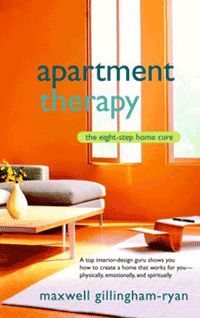
- Apartment Therapy: The Eight Step Home Cure
- Bantam (2006)
- Home Therapy
- Penguin (2005)
- The Itty Bitty Kitchen
- Random House (2006)
When the books Apartment Therapy and Home Therapy landed on my desk, I assumed the psychology reference was ironic. I've often joked that the state of one's home is a reflection of one's psyche, and the most reliable way of vetting potential mates. (You've encountered a grown man who lives with a mattress on the floor and neon beach furniture? Run, run screaming.) It's also fair to say that the piles-o-files in my home suggest a need for some sort of professional intervention -- and, no, I'm not ruling out psychiatrists.
But it seems the decorating world is way ahead of me. What I delivered as snide quips to amuse my friends, they're selling as psychological insight.
One minute these books are talking about strategies for small-space living (get rid of about 80 per cent of everything, seriously) or the rule-of-thumb for where to put the couch (if it has to be against a wall, make it the longest one) and the next minute they're proffering some armchair psychology that suggests they're trying to get you on that couch.
'New Age Wingnuttery'
I'm not blaming the decorating scribes for some of this drivel, since it echoes much of the New Age Wingnuttery (NAW) already churned out by a cynical publishing industry bent on giving P.T. Barnum a run for his money.
No doubt publishers are crossbreeding self-help books with decorating advice to expand the market for both, but the following trio of ugly hybrids offers little more than needless tree-killing.
Particularly disappointing is Apartment Therapy: The Eight-Step Home Cure (Bantam) inspired by designer Maxwell Gillingham-Ryan's small-space living philosophy and his delightful blog, apartmenttherapy.com. For about 80 pages, the book offers a practical plan-of-attack for cleaning and organizing a chaotic home. Sadly, the paperback is 264 pages.
MGR, as his online fans call him, offers some banal musings on what one's décor reveals about one's inner workings and his views are about as meaningful as the average shrink's views on design. Think I exaggerate? There's even a Cosmo-style "therapeutic" questionnaire to "help you get in touch with your personal taste and diagnose your home's physical, emotional, and energy flow issues."
Incidentally, when did it become the done thing to substitute the word "issues" when you mean problems?
'What would your apartment say?'
MGR invites readers to list their favourite actors, restaurants, and clothing stores as a way of gaining insight into themselves. (Because a devotion to Banana Republic and Tom Cruise are just so darn telling?) And there are lots of opportunities to define your self in three words, a game I'm always happy to play. (Why do you live in a tip? Not/Enough/Time. Busy/Reading/Tripe.)
My favourite question is, "What would your apartment say?" Actually, I lost a whole afternoon considering this as a premise for a sitcom tentatively called, If These Walls Could Talk. Retro décor is all the rage, so I figured it would recall some'60s TV classics: a kind of My Mother the Car meets Mister Ed.
And what does my apartment have to say? Yeah, like I'm discussing that in public.
My prescription for the home improvement crowd: skip this book and hit the web site, where the friendly, chatty members of the AT community assemble twice yearly, as a moral support for a group "cure." They offer tips, tricks, confessions and, best of all, before and after shots. It's the endless photos of real people's homes that make this site so addictive.
Over at Random House, the Broadway Books imprint put out The Itty Bitty Kitchen Handbook which offers some useful information for anyone living in major-city micro-apartments. Renters, boat-denizens or students stuck in the eccentric dwellings that seem to be a necessary part of education would also appreciate some of Justin Spring's ideas.
The Manhattan author is a veteran of cooking in teeny kitchens, including his current 45-square-foot one. He takes legendary Chef Escoffier's quote "Do it simply" and applies it to kitchen organization and is cooking-for-one recipes, which are all within the scope of his heavily edited batterie de cuisine.
On the practical side, he has a well-planned list of tools that do double-duty. He prefers pots with lids that lock on and double as strainers. One ultra-sharp microplane can replace all the other shaving and grating tools, including gadgets like lemon-zesters. Glass nesting bowls and baking dishes that come with lids reduce the need for plastic food containers.
Kitchen psychiatric advice
But just as I was thinking the book would be a good housewarming gift for adult children who have been shoved, protesting, out of the nest, Kitchen-Boy goes all armchair shrink. Suddenly he's going on about how to recognize and cope with claustrophobia brought on by working in culinary closets. Then he provides his own vague (and ill-informed) ideas about how to treat depression caused by SAD, too. (That's Seasonal Affective Disorder, and it's real. It's treated with light therapy, from a particular type of light box used in a particular way, all of which is prescribed by a doctor. Changing your kitchen bulbs won't improve anything but the ability to see the dirt that accumulated during your depression.)
The question is why he, or his publisher, thought readers would be interested in psychiatric advice from some guy whose claim-to-fame is organizing kitchens? And given that Spring feels free to print his views on things he obviously knows nothing about, it makes the whole book suspect. I've decided it's a bad idea to foist his recipes on inexperienced cooks and I'm back to handing novices The Joy of Cooking.
By the time I got to Lauri Ward's Home Therapy (Penguin/Perigee) I was certain publishing houses were driving the 12-stepper invasion of House Beautiful.
Judging by her previous work, Ward is one of the most down-to-earth, practical designers out there. She runs New York's Use What You Have decorating and has a book of the same name, that shows you how to apply decorating principles instead of buying the latest gee-gaws.
Imaginary problems
That she has been distracted from the craft of interior design is obvious in her opening line: "Our homes reflect who we are."
Bollocks. Our rooms reflect our decorating skills. They're no more revealing about who we are as individuals than any other hobby. And if you associate with the sort of people who judge you by your home décor, you've got much bigger problems than disorganized closets.
Of course, the subtext to declaring our homes a reflection of the self is the implication that those tatty goods nestled amongst the dust bunnies will expose us as inadequate people. Much the way B.O., ring-around-the-collar, and other imaginary problems were once used to create the self-doubt necessary to sell more -- and more expensive -- hygiene products.
The only difference between Ward's latest offering and her previous books is that she has added an off-putting tone and colour photos to this guide. As in previous books, she lists the 10 most common mistakes -- including uncomfortable conversation areas, poor furniture placement, and misused art, accessories and lighting. Then she shows before-and-after photos of the rooms and explains how she did it. It's well-organized and informative, once you wade through the psychobabble.
Despite it being the season for cleaning, I couldn't recommend any book in this trio because they all share that creepy, offensive tone found in women's magazines and NAW literature -- the notion that we're all sick and damaged and just waiting for some self-appointed guru to save us. As it is, women are the biggest audience for how-to books and, while there are a number of theories about this, I'm inclined to think it has something to do with the relentless social message that, no matter how accomplished she may be, no woman is quite good enough.
While I'm in favour of learning skills for mastering the petty annoyances of daily life, these books are all about peddling nonsense designed to turn (mostly female) readers into victims-for-profit. While there's nothing wrong with the how-to genre, no one needs to read "what's-wrong-with-me?" propaganda penned by people who write as if their knowledge of psychology was gleaned entirely from Cosmo.




